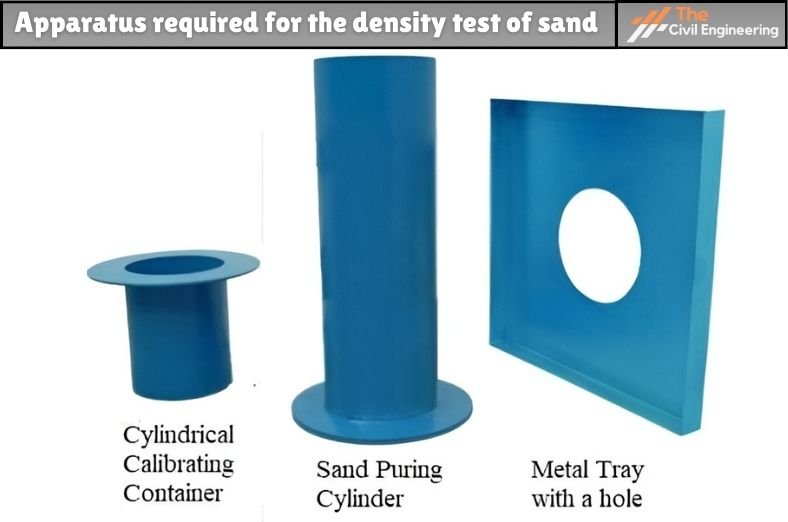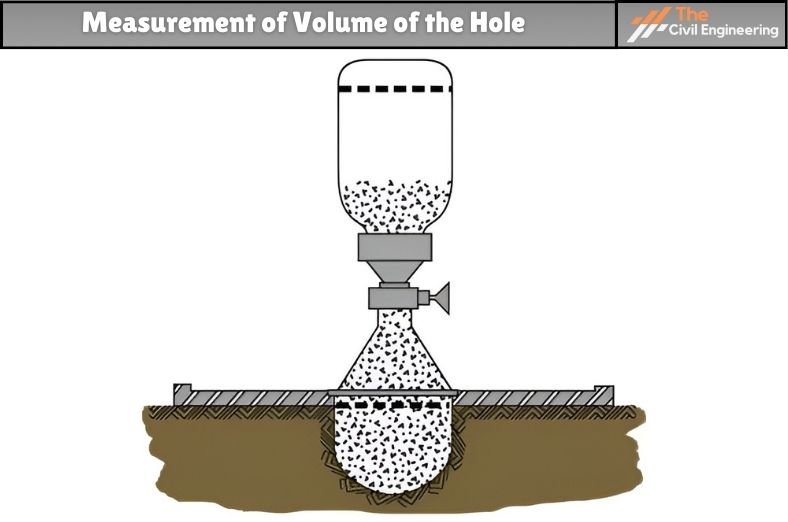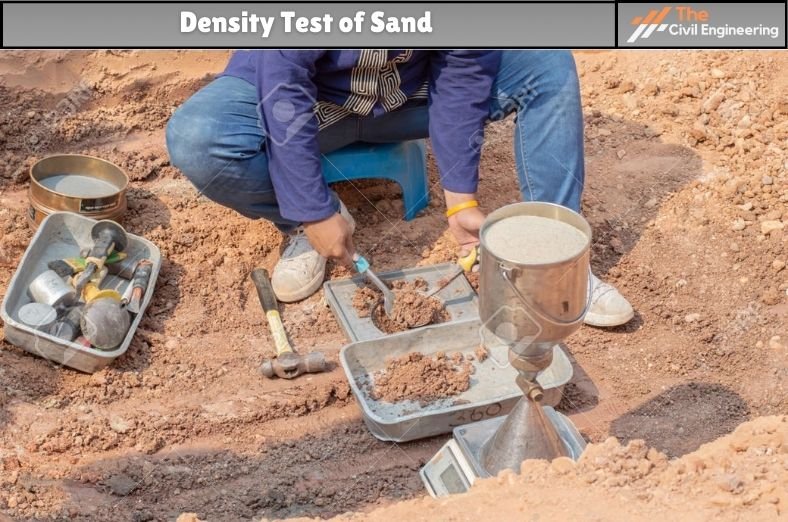1. Introduction
The density of sand is determined by the ratio of the mass of the sand to the volume of calibrating container.
The density test of sand is normally done by the process of the sand cone method. The sand code method is also known as a sand replacement method.
Note: The density of Sand is 1442 kg/m³.
2. Apparatus
The apparatus required for the density test of sand is as follows:
1. Sand cone apparatus is filled with equally graded sand moving through No. 20 sieves and retained on No. 30 sieves.
2. The density plate having a middle circular hole of a radius similar to the radius of the pouring cone.
3. Digging tools.
4. Spoon.
5. Brush.
6. Moisture containers.
7. Oven.

3. Test Standard
| AASHTO | T99-86 |
| ASTM | D 446-82 |
| BS1377 | Part 4. |
4. Calibration of Apparatus
The sand pouring cylinder is filled with sand.
A calibrating container is kept below the sand pouring cylinder, and the shutter is unlocked.
The sand is filled in the calibrating container and the cone.
The total weight of the sand in the calibrating container and the cone is the same as the subtraction between the two observations.
The pouring cylinder is repeatedly filled to the initial weight.
The sand is permitted to pour out of the cylinder, same to the volume of the container and the shutter is locked.
Now the cylinder is then kept over a leveled plane surface, and the shutter is unlocked, the sand flows out of the cylinder and fills the cone.
The shutter is locked when no further flow of sand occurs. The cylinder is replaced and the sand previously filling the cone is gathered and weighted.
The unit weight of the sand can be determined by using this formula:
γ = (w1-w2)-w3 / Vc
Where,
w1 = First weight of the cylinder with sand before putting the sand.
w2 = weight of sand in the cone only.
w3 = Final weight of cylinder after putting sand into the cone and the container.
Vc= Volume of the container.
5. Measurement of Volume of the Hole
A tray with a middle hole is kept on the leveled ground surface which had been cleaned and better managed.
A hole about 50 mm radius and 15 cm deep is dug in the ground, utilizing the hole in the tray as a pattern.
The soil removed is gathered and weighed (w).
The sand pouring cylinder is kept over the dug hole. The shutter is unlocked, and the sand is kept in the cone and the hole.
When the sand stops flowing out then the shutter is locked. The cylinder is separated and weighed.
The volume of the hole is calculated by the weight of sand kept in the hole and the unit weight of sand.
γs = (w1-w2)-w3 / Vc.
Where,
w1 = weight of cylinder and sand before putting into the hole.
w2 = weight of sand in the cone only.
w3= weight of cylinder after putting sand into the hole.
γs= unit weight of sand, as found from calibration.
The bulk unit in-situ soil is calculated from the weight of soil dug and the volume of the hole.
The Wet density or bulk density of soil is calculated by using this formula :
γ = W/V
After Calculating the water content (mc) of soil, the dry density of soil is also calculated by using this formula:
γd = γ/1+m.c

6. Procedure
The following steps are carried out to determine the density test of sand are:
1. Calibration of cone apparatus must be performed initially.
2. Weight the sand cone instrument which is of known density.
3. Place the density plate on leveled and managed clean test ground surface.
4. Excavate soil 4” to 6″ deep with a similar diameter as the density plate hole. Remove all free soil out of the test hole with the help of a brush and spoon.
5. Gather all the dug soil and weigh it.
6. Upturn the sand cone instrument over the density plate and open the valve to lean the hole with sand. When the sand stops moving, lock the valve and separate the instrument from the test hole.
7. Weigh the sand cone instrument with left sand.
8. Gather the sand from the hole as much as possible.
9. Put a sample of the dug soil in the weighed moisture container and place it in the oven for water content calculation.
Result
The density of Sand should be around 1442 kg/m³.
Precautions
1. Sand utilized in this test must be dry.
2. Excavated soil should be collected as a whole.
3. Calibration of cone apparatus should be carried out before starting the test.
QNA
a. What does FDT stand for?
Ans: FDT stands for Field Dry Density.
b. What is the formula to determine water content?
Ans: Moisture content = ((weight of wet soil – weight of dry soil) / weight of dry soil) x 100%
c. Which method is used for the density test of sand?
Ans: The sand replacement method (Sand clone method) is used for the density test of sand.
| Read More:Top 8 Best Types of Tests on Brick |
| Read More:What is a Soak Pit? | Types and Design of Soak Pit |

